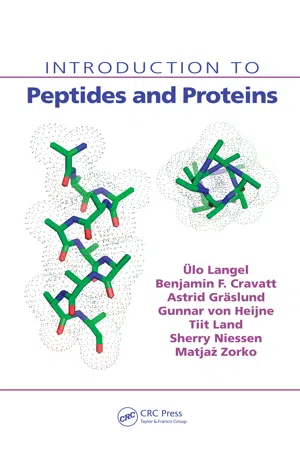Biological Sciences
Denaturation
Denaturation refers to the process in which a protein's structure is altered, leading to loss of its biological activity. This can be caused by factors such as heat, pH changes, or exposure to certain chemicals. Denaturation disrupts the protein's native conformation, affecting its ability to function properly within a biological system.
Written by Perlego with AI-assistance
Related key terms
1 of 5
10 Key excerpts on "Denaturation"
- eBook - PDF
- Martinus A.J.S. van Boekel(Author)
- 2008(Publication Date)
- CRC Press(Publisher)
Denaturation can result in a change of functional properties of proteins, in a loss of enzymatic activity, it may play a part in inactivation of microorganisms (Chapter 13), in an increase in digestibility, in inactivation of antinutritional factors, to name some examples. There is some ambiguity about the question what Denaturation is. Denaturation can be described as a change in the native conformation of a (globular) protein due to a change in conditions. Causes for Denaturation are heat, a change in pH, solvent quality, adsorption to surfaces, high pressure, to name the most important ones for foods. The most relevant cause for foods is, of course, heat. Denaturation does not result in a change in primary structure, but it may result in a change in secondary, tertiary, and quaternary structure. Denaturation does not necessarily result in complete destruction of all native structures, but it will result in an (partial) unfolding of the protein. Such unfolding is in principle reversible, i.e., upon removal of the cause of the unfolding (in the case of heat 10 -1 by cooling) refolding into the original native structure is possible but also into another conformation. This is the very cause of ambiguity: the term Denaturation is also frequently used to indicate irreversible changes in proteins (such as aggregation), but strictly speaking this is not correct. What happens after unfolding is that amino acid residues (buried in the interior of the protein hitherto) become exposed and consequently their reactivity increases and this may result in irre-versible changes. Let us take a closer look at unfolding and further reactions. As indicated above, Denaturation is in principle a reversible process, and equilibrium is postulated between the native and denatured state (assuming this is a one step reaction). This implies that both native and unfolded molecules are present but no unstable intermediate structures. - eBook - PDF
- J.S. Willis(Author)
- 1997(Publication Date)
- Elsevier Science(Publisher)
Three terms must be clearly defined at this point: inactivation, denatu- ration, and irreversibility, Inactivation is defined as the irreversible loss of biological function of any macromolecule. The loss of enzyme cata- lytic activity has been most extensively studied. There are at least seven 226 JAMES R. LEPOCK major causes for the inactivation of proteins: (a) aggregation, (b) thiol- disulfide exchange, (c) chemical modification of sensitive groups, (d) cleavage of disulfides, (e) dissociation of prosthetic groups, (f) dissocia- tion of oligomeric proteins, and (8) irreversible conformational changes (Mozhaev and Martinek, 1982; Zale and Klibanov, 1986). These proc- esses are not independent since the first six processes often occur only after the major conformational change of reversible unfolding and consequently lead to irreversibility. By definition inactivation is irre- versible. The term Denaturation has been used in many ways, which sometimes leads to confusion. A reasonably precise definition has been proposed: “Denaturation is a conformational alteration of a biological macromoleculewhich entails a reversible or irreversible loss of its ability to perform a certain biological function” (Kushner, 1977). Thus, denatu- ration and inactivation are not synonymous since Denaturation involves a major loss of native structure while inactivation can occur by chemical modificationalone. In addition, as will be discussedbelow in more detail, the conformational change associated with Denaturation is a first order, all or none transition from the native to a disordered state which can range in structure from a random coil to the molten globule state. Irreversibility is a relative term meaning that activity or structure is not regained for a long period of time with respect to the time of interest. The reason for irreversibility may be kinetic or thermodynamic. - eBook - PDF
- Ulo Langel, Benjamin F. Cravatt, Astrid Graslund, N.G.H. von Heijne, Matjaz Zorko, Tiit Land, Sherry Niessen(Authors)
- 2009(Publication Date)
- CRC Press(Publisher)
6.1 STABILITY OF THE PROTEIN STRUCTURE AND Denaturation Most of the current knowledge about the stability of the protein structure and the folding processes has come from studying protein Denaturation and subsequent rena-turation. Proteins in the compact, folded conformation exhibit secondary, tertiary and, in some cases, also quaternary structures, as described in previous chapters. The primary structure of the protein and the proper environment are usually suffi-cient to ensure the functional, native conformation of the proteins. At all levels higher than the primary structural level, it is predominantly weak interactions that operate, assisted by covalent disulfide bridges if they are present. However, by changing the protein environment, these bonds can be broken, resulting in protein Denaturation. This Denaturation is, by definition, a loss of all the levels of protein structure except the primary structure because only the peptide bonds and sometimes the disulfide bridges remain intact. Denaturation can be achieved by increasing the temperature, changing the pH to either extreme, increasing the pressure, or adding denaturants, that is, chemicals such as guanidinium chloride or urea (see Equation 6.3). C NH 2 + H 2 N NH 2 Cl – C H 2 N NH 2 O guanidinium chloride urea (6.3) Sometimes the reduction of the disulfide bridges or the removal of the cofactors will also lead to Denaturation, and the stability of the protein structure can also be affected by mutations, for example, by the site-specific replacement of any of the crucial resi-dues or by truncating the sequence. With small proteins, Denaturation is a two-state process, described by Equation 6.1, and is usually fully reversible. However, with larger proteins, particularly those composed of several domains, the process is mul-tistep and not always reversible. - J. A. V. Butler, J. T. Randall(Authors)
- 2016(Publication Date)
- Pergamon(Publisher)
It has often been considered that Denaturation is analogous to the transformation from the crystalline to the amorphous state, although the process of Denaturation appears rather to be the modification of a highly specific structure to give rise to a more random arrangement. (19) ' (40) Such a change in the molecular configuration allows, for instance, the exposure of SH groups, which may be unavailable due to steric hindrance in the native protein. (81) As we have already seen, changes in particle size, caused by dissociation or aggregation, are the most direct manifestation of a structural transformation. Dissociation is quite a frequent phenomenon. For instance, at room temperatures and outside thepH range 4-9, the serum albumin molecule splits into smaller particles, the first step (into half molecules) being reversible, while on heating amandin, part of the molecule dissociates into very small particles. (24) Nevertheless, practically nothing is known about the mechanism of such behaviour. As explained above, the mechanism of aggregation has been more fully elucidated, particularly in the case of insulin. (106) ' (126) > (151) » (218) Here each molecule undergoes only small structural changes during fibril formation, the globular units being reversibly linked endwise; the heat of dissociation falls with increase of charge. The variation of 209 REVERSIBLE Denaturation OF PROTEINS viscosity of serum albumin with ρΉ. in acid media has been inter-preted^ 2 ^ in terms of reversible associations: A -f H + ^ ± A H + and nXK+ ^± (AK + )n. More generally, it has been shown that, if denatura-tion is accompanied by aggregation, the apparent (directly measured) free energy of activation includes a term corresponding to the proba-bility of the particles colliding and aggregating, so that the free energy of activation of the true Denaturation may be 3 or 4 times smaller.- eBook - ePub
Protein Actions
Principles and Modeling
- Ken Dill, Robert L. Jernigan, Ivet Bahar, Ken A. Dill(Authors)
- 2017(Publication Date)
- Garland Science(Publisher)
chaperones , which help other proteins fold inside cells and prevent their misfolding and aggregation. Nevertheless, many small single-domain proteins are routinely unfolded and refold reversibly in test tubes, without biological helper molecules. Hence, native structures of proteins are stable equilibrium states of matter.Figure 3.1 Proteins are denatured by increasing temperature or denaturant concentration. (A) The thermal Denaturation of ribonuclease A, as determined by spectroscopic and viscosity measurements. (B) The urea-induced Denaturation of ribonuclease T1, as determined by spectroscopic methods. (A, from A Ginsburg and WR Carroll. Biochemistry , 4:2159–2174, 1965; B, from JA Thomson, BA Shirley, GR Grimsley, and CN Pace. J Biol Chem , 264:11614–11620, 1989. © 1989 The American Society for Biochemistry and Molecular Biology.)The Basic Experiment of Protein Stability Is Equilibrium Denaturation
The basic experiment that measures protein stability is equilibrium Denaturation. You make up a series of different protein solutions,, having different amounts of denaturing agent1 , 2 , … , M. By “denaturing agent,” we mean either temperature or a chemical, such as guanidinium hydrochloride (GuHCl), urea, alcohol, or acids or bases, for example. Then, for each particular solution, having denaturing agent in amount x , you measure (typically by some form of spectroscopy) the proportionx 1,x 2, … ,x Mof native protein molecules and the proportionf N( x )of denatured protein molecules (assuming you observe only the two states, a common situation). Increasing the denaturing agent increases the population off D( x )= 1 -f Nrelative toD. In the absence of denaturing agent, the protein is fully native (except for fluctuations). In high concentrations of denaturing agent, the protein is denatured. Figure 3.1A shows Denaturation by high temperatures; Figure 3.1B shows Denaturation by high concentrations of urea. Such plots, called melting or Denaturation curves, are typically sigmoidal in shape, as a function of denaturing agent xN - eBook - PDF
Biocalorimetry 2
Applications of Calorimetry in the Biological Sciences
- John E. Ladbury, Michael L. Doyle(Authors)
- 2005(Publication Date)
- Wiley(Publisher)
(1992) Biochemistry 31: 3947–3955. 18. Luque I and Freire E. (1998) Methods Enzymol. 295: 100–127. 19. Nadassy K, Wodak SJ and Janin J. (1999) Biochemistry 38: 1999–2017. 20. Gorfe AA, Caflish A and Jelesarov I. (2004) J. Mol. Recognit. 17: 121–131. 21. Jen-Jacobson L, Engler LE and Jacobson LA. (2000) Structure 8: 1915–1923. 202 ENERGETICS OF SITE-SPECIFIC DNA RECOGNITION 11 Linkage Between Temperature and Chemical Denaturant Effects on Protein Stability: the Interpretation of Calorimetrically Determined m Values Beatriz Ibarra-Molero, Raul Perez-Jimenez, Raquel Godoy-Ruiz and Jose M. Sanchez-Ruiz 11.1 Introduction Two experimental approaches are commonly employed to characterize the thermodynamic stability of proteins: (1) thermal Denaturation studies, often monitored by differential scanning calorimetry (DSC); (2) chemical Denaturation studies, in which Denaturation is induced by urea or guanidine. In principle, DSC studies on thermal Denaturation offer several advantages. Provided that the DSC profiles accurately reflect an equilibrium Denaturation process, the equilibrium thermodynamics analysis may lead to the number and thermodynamic parameters (Gibbs energy, enthalpy, entropy, heat capacity) of the protein states significantly populated during Denaturation. 1–5 On the other hand, analysis of chemical Denaturation profiles (value of a physical property versus urea or guanidine concentration) 6,7 is to a large Biocalorimetry 2. Edited by John E. Ladbury and Michael Doyle. & 2004 John Wiley & Sons, Ltd. ISBN 0 470 84968 1 extent empirical and based upon extrathermodynamic assumptions. Thus, evidence supporting two-state Denaturation must often be derived from the comparison of several Denaturation profiles obtained using different physical properties or from direct measurements of the concentration of native protein using time-consuming double-jump assays. - eBook - PDF
Protein Engineering
Approaches to the Manipulation of Protein Folding
- Saran A. Narang(Author)
- 2013(Publication Date)
- Butterworth-Heinemann(Publisher)
22 Experimental Approaches to Protein Folding laboratories. These are exemplified by papers by Simpson and Kauzmann (1953), Tanford et al. (1954), Steinhardt et al. (1958), and Hermans and Scheraga (1961). Kauzmann's classic review (1959) provided a critical syn-thesis of model compound and protein studies, firmly establishing the ther-modynamic basis for Denaturation studies. A decade later Tanford (1968 and 1970) thoroughly reviewed experimental Denaturation studies and the progress in developing theoretical treatments. These studies established that protein Denaturation may often be reversible. Moreover, a number of small stable proteins showed equilibrium Denaturation behavior that could be clearly fit to a two-state model: native ^ denatured, with no intermediates required. Figure 2-1 shows a good example from the studies of Ginsburg and Carroll (1965) on the acid Denaturation of ribonuclease A (RNase A). For several proteins the free energy of Denaturation has been estimated to be in the range of 5-15 kcal/mol at room temperature and neutral pH (Kuntz 1984). Thermodynamic analysis of reversible Denaturations is straightforward when the system behaves as if there are only two states of the protein: native and denatured. Then one can readily determine the equilibrium between the two states as a function of temperature, pH, dénaturant concentration, etc., and express the equilibrium constant in terms of free energy and its enthalpic and entropie components. On the other hand, if there are inter-mediates, i.e., more than two states, it is much more difficult to experi-mentally evaluate the equilibrium constants. It becomes even more difficult to infer what structural changes are reflected in each equilibrium. Because of its analytical tractability, two-state behavior in protein Denaturation was for a time highly prized by biophysical chemists. - Thomas M. Devlin(Author)
- 2015(Publication Date)
- Wiley-Liss(Publisher)
Such a process is called cooperative. The presence of a short double helix serves as a nucleation site for annealing by facilitating the formation of subsequent base pairs. Denaturation is the same process in reverse: A bubble serves as an initiation site for unstacking of the nucle- obases and rapid unzipping of the helix. 1.1 1.0 100 50 0 1.2 1.3 1.4 50 30 70 90 Transition breadth Relative optical density (260 nm) Percent hypochromicity (°C) T m Figure 2.18 Temperature-optical density profile for DNA. When DNA is heated, the absorbance at 260 nm increases with rising temperature. A graph in which absorbance versus temperature is plotted is called a melting curve. Relative optical density is the ratio of the absorbance at any temperature to that at low temperatures. The temperature at which one-half of the maximum optical density is reached is the midpoint temperature T m . C G T C A T G G C A G T A C G T C A T G C A G T A C C G C T C A T G G A G T A C G C C C A T G G G T A C G C T A C A T G G T A C G C T A C G very slow formation of nucleation site helix propagation fast G T C A T G C A G T A C C G Figure 2.19 Cooperativity of renaturation/Denaturation of DNA double helices. During renaturation, formation of the first correct base pair is very slow. Annealing of neighboring pairs is facilitated, especially after formation of a 3- to 5-bp nucleation site. Denaturation follows a similar course, but the order of steps is reversed. Redrawn from Saenger, W. Principles of Nucleic Acid Structure. New York: Springer-Verlag, 1984, 141. 38 • PART I STRUCTURE OF MACROMOLECULES Hybridization A technique based on the association of complementary polynucleotide strands, hybrid- ization has been developed for the detection and quantitation of specific sequences of target nucleic acid.- eBook - ePub
Coulson and Richardson's Chemical Engineering
Volume 3A: Chemical and Biochemical Reactors and Reaction Engineering
- R. Ravi, R. Vinu, S. N. Gummadi(Authors)
- 2017(Publication Date)
- Butterworth-Heinemann(Publisher)
One of the major problems that a biochemical engineer will encounter is that of the stability of protein materials. The biological function of the molecule is determined by its secondary and tertiary structures, and if these are upset irreversibly then the protein becomes denatured. Denaturation can occur under relatively mild conditions, as proteins are usually stable only at very narrow ranges of pH (e.g., 5–8) and temperature (e.g., 10–40°C). The boiling of an egg illustrates this point. In its uncooked form the white is a slimy clear protein solution, but under acidic conditions, or when put in boiling water, the solution gels to white solid. The stability of tertiary structure can be appreciated by the relative strengths of these associations as compared with that of a covalent bond.5.2.4. Nucleic Acids
The basic monomers of nucleic acids are nucleotides, which are made up of heterocyclic nitrogen-containing compounds, purines, and pyrimidines, linked to pentose sugars. There are two types of nucleic acids, and these can be distinguished on the basis of the sugar moiety of the molecule. Ribonucleic acids (RNA) contain ribose, whereas deoxyribonucleic acid (DNA) contains deoxyribose. The bases cytosine (C), adenine (A), and guanine (G) are common in both RNA and DNA. However, RNA molecules contain a unique base, uracil (U), whereas the unique DNA base is thymidine (T).5.2.4.1. Deoxyribonucleic Acid Structure
DNA is a linear polymer of nucleotides linked via phosphodiester bonds, which are formed between the 3′ and 5′ hydroxy groups of the ribose moiety of the nucleotide. Fig. 5.12 shows the covalent backbone of DNA. These polymers are normally found as an aggregated pair of strands held together by hydrogen bonding (Fig. 5.13 ). DNA is composed of four nucleotides: adenine (A), thymine (T), guanine (G), and cytosine (C). The primary structure of DNA is the linear sequence of nucleotide residues comprising the polydeoxyribonucleotide chain. DNA varies in length and in nucleotide composition, the shortest molecules being in the order of 103 bases in viruses, 106 in bacteria, and 108 - eBook - PDF
- Ilya Prigogine, Stuart A. Rice(Authors)
- 2009(Publication Date)
- Wiley-Interscience(Publisher)
The three-dimensional structure of a native protein in solution is sup- posed to be determined by minimizing the Gibbs free energy of a given polypeptide chain in a given environment. This thermodynamic origin of the native structure is clearly demonstrated by renaturation experiments. The refolding of the native structure of ribonuclease, after full denatura- tion by reductive cleavage of its four disulfide bonds, was observed by Anfinsen et al.' Since the refolding of this molecule requires only 1 of the 105 possible pairings of eight sulfhydryl groups to form four disulfide linkages, thermodynamic stability of the native conformation is indicated even in the polypeptide chain before linking of the disulfide bonds. The native ordered structure of proteins is altered to the unfolded state by Denaturations induced by the change of external conditions, such as temperature, pressure, and the compositions of low-molecular-weight so- lutes. The unfolding of native structure is usually reversible and appears sharply under certain external conditions, suggesting the important role of cooperative interactions. STATISTICAL THERMODYNAMICS OF PROTEINS 365 The equilibrium properties of the Denaturation are commonly accounted for by the simple two-state model in which only two conformational states are assumed for the protein structure.'" The kinetic properties of the Denaturation, however, apparently contradict the simple two-state model, because two, or sometimes three, relaxation times are observed in the de- naturation processes.' Although the cooperative interaction is essential to maintain the native protein structure, it is unlikely that the cooperative effects are sufficient to cover all the secondary bonds in a protein as predicted by the simple two- state model, and local fluctuations in structure are expected even in a highly ordered native state. In fact, hydrogen exchange kinetics8-" and highly re- solved nuclear magnetic resonance spectroscopy".
Index pages curate the most relevant extracts from our library of academic textbooks. They’ve been created using an in-house natural language model (NLM), each adding context and meaning to key research topics.









